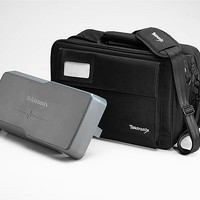ACD2000 Tektronix, ACD2000 Datasheet - Page 8

ACD2000
Manufacturer Part Number
ACD2000
Description
Benchtop Oscilloscopes SOFT CASE FOR SERIES OSCILLOSCOPES
Manufacturer
Tektronix
Type
Caser
Datasheet
1.ACD2000.pdf
(11 pages)
Specifications of ACD2000
Equipment Type
Case
Accessory Type
Large Nylon Soft Case
Lead Free Status / RoHS Status
Lead free / RoHS Compliant
For Use With
DPO/MSO2000 Series Oscilloscopes
Acquisition Modes
Sample – Acquires sampled values.
Peak Detect – Captures glitches as narrow as
3.5 ns at all sweep speeds.
Averaging – From 2 to 512 waveforms included
in average.
Roll – Scrolls waveforms right to left across screen
at sweep speeds slower than or equal to 40 ms/div.
Trigger System
Main Trigger Modes – Auto, Normal and Single.
Trigger Coupling – DC, HF reject (attenuates
>85 kHz), LF reject (attenuates <65 kHz), noise
reject (reduces sensitivity).
Trigger Holdoff Range – 20 ns to 8 s.
Trigger Signal Frequency Counter – Provides a
higher accuracy means of identifying the frequency
of trigger signals. Trigger Signal Frequency counter
resolution is 6 digits.
Trigger Level Range
Any Channel – ±4.92 divisions from center
of screen.
External (auxiliary input) – ±6.25V, 1x attenuation;
±12.5V, 10x attenuation.
Sensitivity
Internal DC Coupled
Trigger Source
Analog Inputs
External
(Auxiliary Input)
Digital Phosphor Oscilloscopes • www.tektronix.com/mso2000 • www.tektronix.com/dpo2000
Sensitivity
0.4 division from DC to 50 MHz
0.6 divisions >50 MHz to 100 MHz
0.8 divisions >100 MHz to 200 MHz
200 mV from DC to 100 MHz,
1x attenuation
Trigger Modes
Edge – Positive or negative slope on any channel or
front-panel auxiliary input. Coupling includes DC, HF
reject, LF reject, and noise reject.
Pulse Width – Trigger on width of positive or negative
pulses that are >, <, =, or ≠ to a specified period
of time.
Runt – Trigger on a pulse that crosses one
threshold but fails to cross a second threshold
before crossing the first again.
Logic – Trigger when any logical pattern of channels
goes false or stays true for specified period of time.
Any input can be used as a clock to look for the pattern
on a clock edge. Pattern (AND, NAND) specified for
all analog and digital input channels defined as High,
Low, or Don’t Care.
Setup and Hold – Trigger on violations of both
setup time and hold time between clock and data
present on any of the input channels.
Rise/Fall Time – Trigger on pulse edge rates that
are faster or slower than specified. Slope may be
positive, negative, or either.
Video – Trigger on line number, all lines, odd, even,
or all fields on NTSC, PAL and SECAM video signals.
I
Stop, Missing ACK, Address (7 or 10 bit), Data, or
Address and Data on I
SPI (Optional) – Trigger on SS, Idle Time, MOSI,
MISO, or MOSI and MISO on SPI buses up to
10.0 Mb/s.
CAN (Optional) – Trigger on Start of Frame, Frame
Type (data, remote, error, overload), Identifier (stan-
dard or extended), Data, Identifier and Data, End of
Frame, Missing ACK, or Bit Stuffing Errors on CAN
signals up to 1 Mb/s. Data can be further specified
to trigger on ≤, <, =, >, ≥ or ≠ a specific data value.
User-adjustable sample point is set to 50% by default.
RS-232/422/485/UART (Optional) – Trigger on
Tx start bit, Rx start bit, Tx end of packet, Rx end
of packet, Tx data, Rx data, Tx Parity Error, and Rx
Parity Error.
LIN (Optional) – Trigger on Sync, Identifier, Data,
Identifier and Data, Wakeup Frame, Sleep Frame,
or Errors such as Sync Parity or Checksum Errors.
Parallel (available on MSO models only) – Trigger
on a parallel bus data value.
2
C (Optional) – Trigger on Start, Repeated Start,
2
C buses up to 3.4 Mb/s.
Waveform Measurements
Cursors – Waveform and Screen
Automatic Measurements – 29, of which up to
four can be displayed on screen at any one time.
Measurements include Frequency, Period, Delay,
Rise Time, Fall Time, Positive Duty Cycle, Negative
Duty Cycle, Positive Pulse Width, Negative Pulse
Width, Burst Width, Phase, Positive Overshoot,
Negative Overshoot, Peak-to-Peak, Amplitude, High,
Low, Max, Min, Mean, Cycle Mean, RMS, Cycle
RMS, Positive Pulse Count, Negative Pulse Count,
Rising Edge Count, Falling Edge Count, Area and
Cycle Area.
Gating – Isolate the specific occurrence within an
acquisition to take measurements, using either the
screen or waveform cursors.
Waveform Math
Arithmetic – Add, subtract, and multiply waveforms.
Software
NI LabVIEW SignalExpress
A fully interactive measurement software environ-
ment optimized for the MSO2000/DPO2000 Series,
enables you to instantly acquire, generate, analyze,
compare, import, and save measurement data and
signals using an intuitive drag-and-drop user inter-
face that does not require any programming. Standard
MSO2000/DPO2000 Series support for acquiring,
controlling, viewing and exporting your live signal
data is permanently available through the software.
The full version (SIGEXPTE) adds additional signal
processing, advanced analysis, mixed signal,
sweeping, limit testing, and user-defined step capa-
bilities and is available for a 30-day trial period stan-
dard with each instrument.
OpenChoice
communication between a Windows PC and the
MSO2000/DPO2000 Series, using USB or LAN.
Transfer and save settings, waveforms, measure-
ments and screen images.
IVI Driver – Provides a standard instrument
programming interface for common applications
such as LabVIEW, LabWindows/CVI, Microsoft
.NET and MATLAB.
Digital Phospor Oscilloscopes
MSO2000 Series • DPO2000 Series
®
Desktop – Enables fast and easy
TM
Tektronix Edition LE –
9










